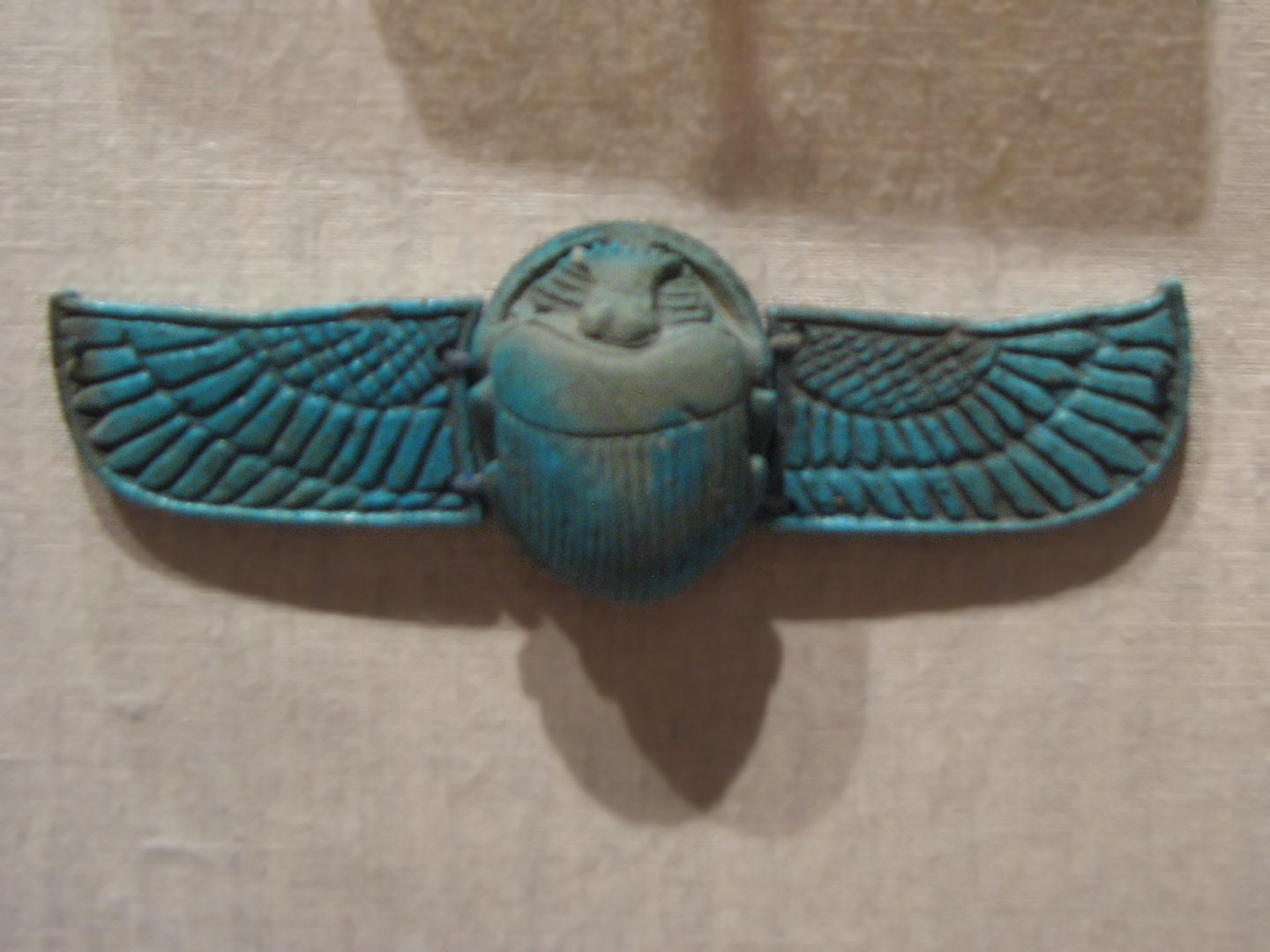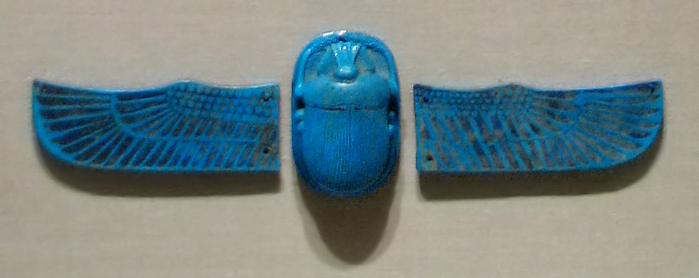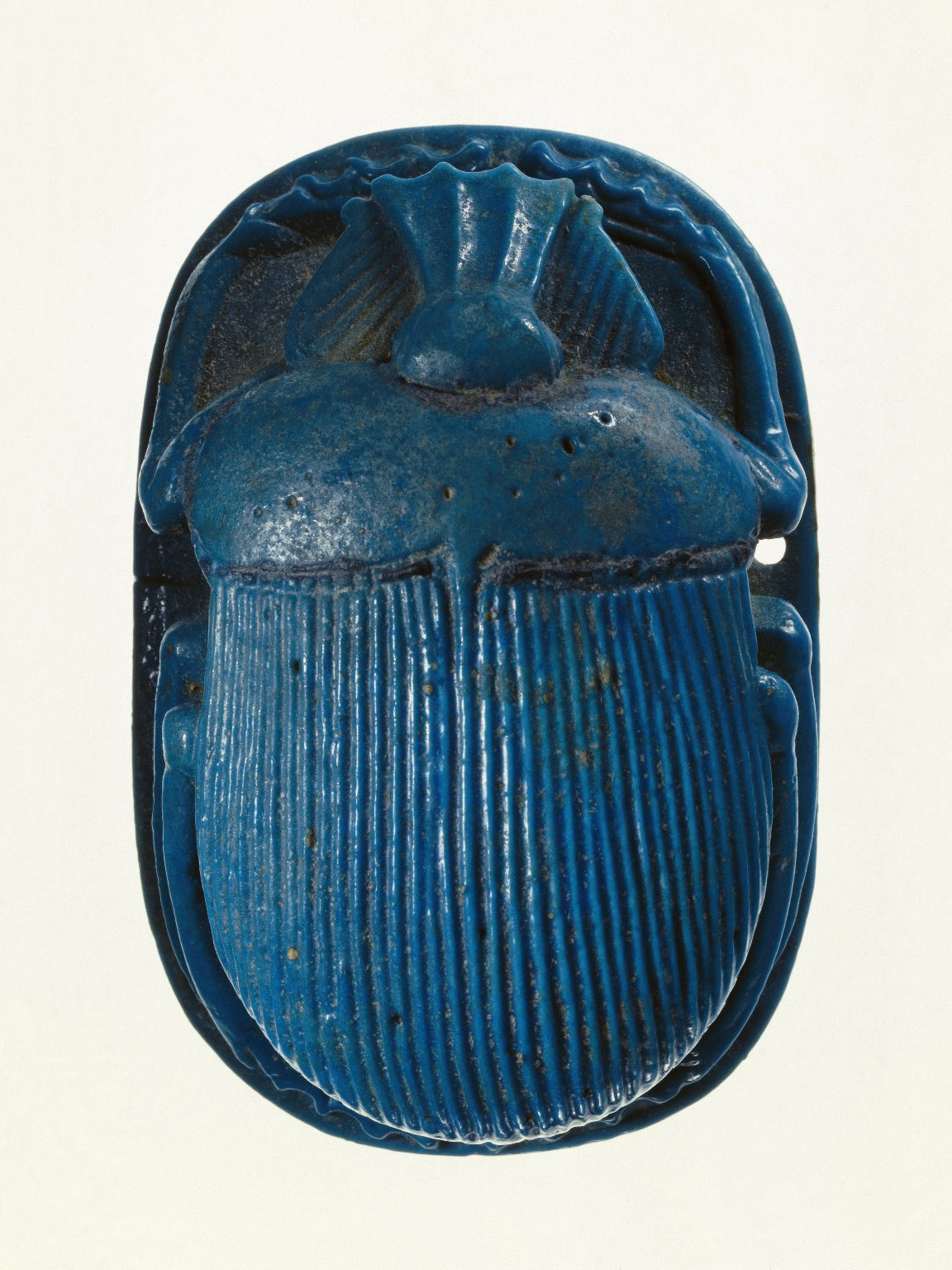
Faience scarab with attached wings
New Kingdom, XVIII Dynasty - XX Dynasty, ca. 1539 B.C.E. - 1070 B.C.E.
Glazed Faience, scarab size: 1/2 x 1 1/16 x 1 5/16 in. (1.2 x 2.7 x 3.3 cm)
Accession Number: Broolyn X249.42
 Scarab with Separate Wings Egypt Third Intermediate Period-Late Period, second half of XXV Dynasty-XXX Dynasty (712-342 B.C.E.) Glazed Faience Scarab: 11/16 x 1 5/8 x 2 1/2 in. (1.8 x 4.2 x 6.3 cm) Wing: 1 5/16 x 3 3/4 in. (3.4 x 9.6 cm) Brooklyn #49.28a-c, Charles Edwin Wilbour Fund Photos © Joan Lansberry, May 2008 |
 |
|
Bob Brier writes: "Perhaps the reason the ankh was not more popular as an amulet was that there was another to serve the same function: the scarab. These are carved in the shape of a beetle, the Scarabaeus sacer, from which the modern word comes." Scarab amulets are abundant, the Metropolitan museum has a whole shelf full of them . And here are the inscribed backs of two 'motto' scarabs which the Brooklyn Museum has:
"There are several reasons why the scarab became such an important amulet. The Egyptians were especially fond of puns, and the hieroglyphs for beetle (pronounced kheper) also meant 'to exist'. So if you wore a scarab amulet, your continued existence was assumed." (_Ancient Egyptian Magic_), pages 145-146) Actually, the Egyptians had two different words for 'to exist', with different meanings. One is an active state of becoming, which is the kheper scarab. The other is a static state, which does not change. Furthermore, "The Egyptians distinguished between cyclical and non-cyclical time, calling the former neheh and the latter djet. Neheh, or cyclical time, is the never-ending recurrence of the same; it is generated by the movement of the heavenly bodies and hence determined by the sun. This kind of time is associated with the concept of 'becoming,' represented in the Egyptian script by the image of the scarab, the central symbol of salvation in Egyptian thought, which itself pivoted not of the idea of Being but Becoming." (_The Mind of Egypt_, Jan Assmann, page 18) Djet never changes, it is static. Osiris is "lord of djet: 'Wennefer'..." (Ibid) is his title, 'beautiful existence', "immutable permanence", wen=existence, nefer=beautiful. "The crouching hare was also a hieroglyph, with the sound value wn (wen). Among its most frequent uses was in writing a word meaning, 'to be,' 'to exist.' _Eternal Egypt: Masterworks of Ancient Art from the British Museum_, by Thomas Garnet Henry James, and others, page 162) But wen-existence is not a becoming-into-being existence. Thus, for hope of regeneration, the kheper-scarab is the desired amulet. There's further reasons why the ancients liked the scarab. They thought the scarab reproduced "without the union of male and female", "like the god Atum who begot children without a female partner." Also, "the scarab was revered is that when the scarab fashions the dung ball it rolls it with its hind legs to a sunny place. To the ancient mind this in some way resembled the journey of the sun across the sky" (Brier, _AEM_, page 146), a cyclical occurrence. "Aside from its use as an amulet, a seal, and a commemoration, the scarab was also a crucial funerary object." (Ibid, page 152) The museum website explains, "Nets made of faience beadwork became a fashionable feature of mummy wrappings in the Late Period. Faience amulets formed part of the beadwork pattern and served to protect the mummy through their magical properties. This scarab is one of the finer examples of such amulets. It served as a substitute heart that would ensure continued existence in the hereafter."
|


